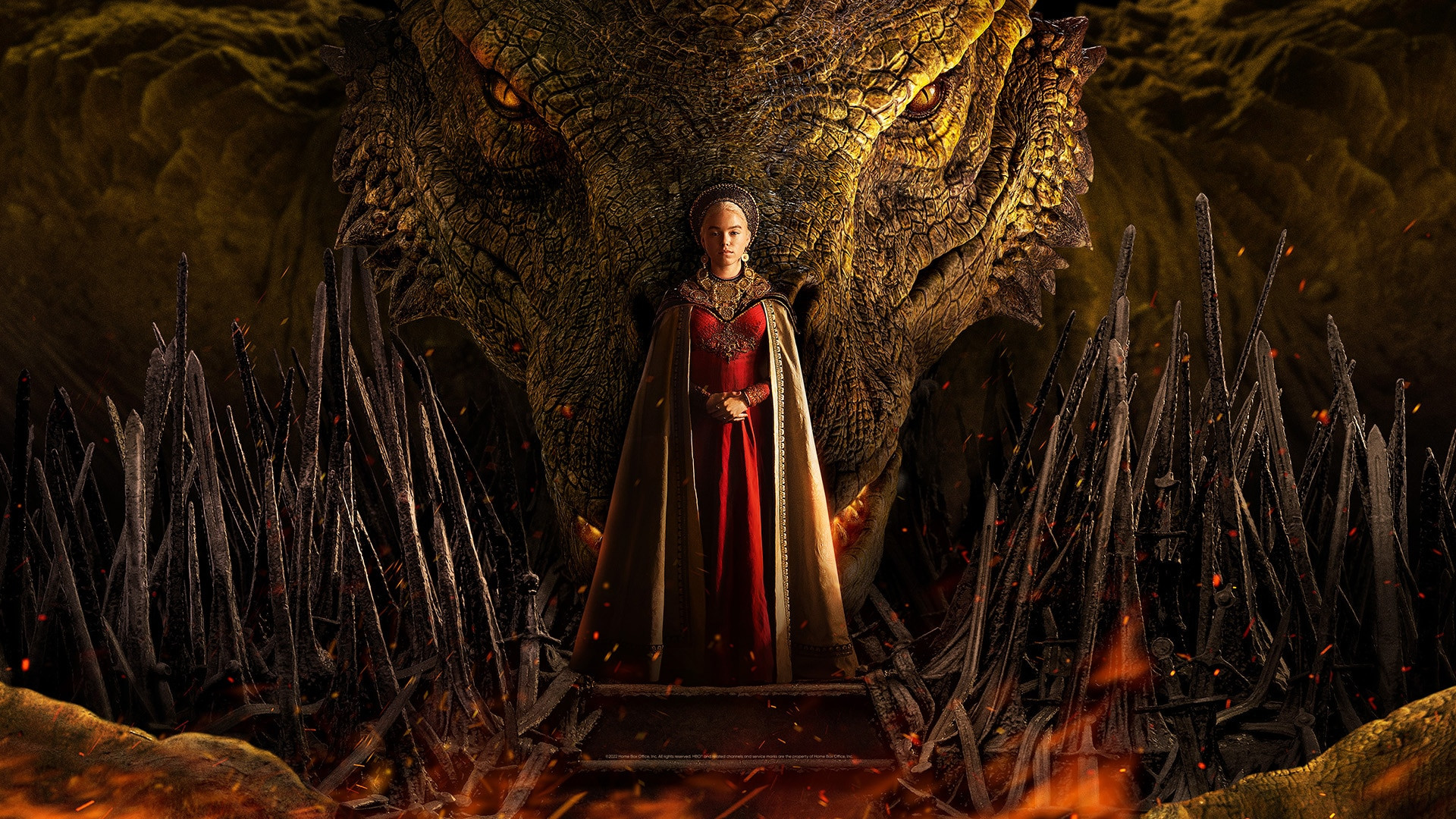Last year, an in-depth analysis explored the conflicts within George R. R. Martin’s A Song of Ice and Fire through the lens of just war principles. This examination delved into the actions of the primary combatants leading up to and during the War of the Five Kings, questioning the just cause of each side.
Now, we turn our attention to The Dance Of The Dragons, the fiery civil war at the heart of the Game of Thrones prequel, House of the Dragon. Drawing primarily from Fire and Blood, Martin’s historical account of the Targaryen dynasty, this analysis will assess the justifications and actions of the key players in this devastating conflict.

The Contested Throne: Claims to Power in the Dance of the Dragons
The Dance of the Dragons erupted from a succession crisis within House Targaryen, pitting Princess Rhaenyra, King Viserys I’s eldest child, against her younger half-brother, Aegon II. Much of the moral debate surrounding this civil war centers on the legitimacy of their competing claims, making it crucial to evaluate each claimant’s position to understand the conflict’s origins.
Rhaenyra Targaryen often appears as the more righteous claimant, particularly to modern audiences. As Viserys’s firstborn and designated heir, her claim seems straightforward. The primary challenge to her succession – her gender – resonates poorly today. Consequently, House of the Dragon and related discussions frequently portray Rhaenyra and her “Black” faction as protagonists against Aegon and the “Green” usurpers.
However, reducing the succession dispute to gender alone overlooks the complexities of feudal legitimacy. Monarchical legitimacy in feudal systems is fluid and multifaceted, influenced by factors beyond primogeniture or royal decree. These include the previous monarch’s wishes, the consensus of the court and powerful lords, established legal precedents, and the perceived qualities of the claimants themselves.
A glance at Targaryen or real-world history reveals that legitimacy is a shifting concept. Aegon the Conqueror’s claim rested solely on conquest. King Jaehaerys I was chosen as a compromise candidate by the realm’s lords. Viserys I himself was elected by the Great Council of 101.
Indeed, George R. R. Martin masterfully illustrates the capricious nature of feudal monarchy throughout his works. Rules are manipulated and reinterpreted to serve individual ambitions. In the War of the Five Kings, each claimant possessed a plausible, if self-serving, justification. Even Rhaenyra, during the Dance, bent the rules of inheritance when politically expedient, favoring younger male heirs over older female heirs for Houses Rosby and Stokeworth.
Therefore, rather than dissecting every detail of Rhaenyra and Aegon II’s claims, it’s more pertinent to acknowledge that both had reasonable grounds to pursue the Iron Throne. Rhaenyra had King Viserys’s explicit endorsement and the support of significant lords. Aegon garnered support from the court and other lords, bolstered by centuries of legal tradition, culminating in the precedent set by the Great Council of 101.
The critical question, then, shifts from the minutiae of their claims to their actions in the pivotal weeks following Viserys’s death. Who prioritized diplomacy? Who initiated hostilities? And ultimately, who bore greater responsibility for plunging Westeros into the Dance of the Dragons?
Diplomacy or Declaration of War? The Failure to Negotiate
In the aftermath of Rhaenyra and Aegon II’s separate coronations, both factions engaged in diplomatic exchanges, or rather, presented ultimatums. Rhaenyra initiated the dialogue with terms that ostensibly aimed to prevent war.
“[Rhaenyra’s] first act as queen was to declare Ser Otto Hightower and Queen Alicent traitors and rebels. “As for my half-brothers and my sweet sister, Helaena,” she announced, “they have been led astray by the counsel of evil men. Let them come to Dragonstone, bend the knee, and ask my forgiveness, and I shall gladly spare their lives and take them back into my heart, for they are of my own blood, and no man or woman is as accursed as the kinslayer.”
Fire and Blood
Rhaenyra’s demands were remarkably uncompromising. She offered only to spare the lives of Aegon II, his wife Helaena, and his brothers, contingent on their complete submission and plea for forgiveness. Crucially, she made no guarantees regarding the fates of Otto Hightower, Alicent, or Aegon’s other supporters. Furthermore, she provided no assurances of maintaining Aegon and his family’s titles, lands, or social standing. Accepting Rhaenyra’s terms would have left Aegon and his faction powerless and vulnerable, hardly a foundation for peaceful resolution. Her proposal lacked the substance of a genuine attempt at de-escalation.
In contrast, the Green Council’s counteroffer presented a different approach.
“The terms offered by the king were generous, Munkun declares in his True Telling. If the princess would acknowledge him as king and make obeisance before the Iron Throne, Aegon II would confirm her in her possession of Dragonstone, and allow the island and castle to pass to her son Jacaerys upon her death. Her second son, Lucerys, would be recognized as the rightful heir to Driftmark, and the lands and holdings of House Velaryon; her boys by Prince Daemon, Aegon the Younger and Viserys, would be given places of honor at court, the former as the king’s squire, the latter as his cupbearer. Pardons would be granted to those lords and knights who had conspired treasonously with her against their true king.”
Fire and Blood
While labeling Aegon’s terms as “generous,” as Maester Munkun does, might be an exaggeration, they were undeniably more conciliatory than Rhaenyra’s. Aegon’s council extended pardons beyond Rhaenyra’s immediate family to encompass all her supporters. More significantly, they guaranteed land and authority to Rhaenyra and her children. Retaining Dragonstone, a formidable and prestigious seat, would ensure Rhaenyra’s security and future influence. The inclusion of her allies in the pardon further solidified her political survival.
However, the initial offer was not without its contentious points. Placing Rhaenyra’s younger sons at court could be interpreted as demanding hostages to ensure her compliance. Nevertheless, these terms provided a viable starting point for negotiation. A more pragmatic ruler might have countered, mirroring the intricate exchanges between Tywin Lannister and Robb Stark during the War of the Five Kings. Yet, when Grand Maester Orwyle delivered the Green terms to Dragonstone, Rhaenyra summarily rejected them, violently stripping him of his chain of office.
The Green Council’s relatively moderate terms become even more significant considering their superior military position at the war’s outset. Logically, Rhaenyra, facing a weaker position, should have offered more enticing terms, not the reverse. In essence, the Greens demonstrated a greater inclination to prevent bloodshed through diplomatic channels, however imperfect.
A Question of Perspective: Unreliable Narrators in Fire and Blood
It’s important to acknowledge the potential bias within Fire and Blood‘s historical accounts, which some readers suspect leans against Rhaenyra and the Blacks. Munkun’s description of the Green terms as “generous” exemplifies this potential slant. Further perspectives might illuminate Rhaenyra’s actions more favorably. However, for now, we must analyze the Dance of the Dragons based on the available historical record.
The Spark of War: Lucerys’s Death and No Turning Back
While failed diplomacy set the stage for conflict, mobilizing armies on both sides, war was not yet inevitable. The Dance of the Dragons ignited with the death of Lucerys Velaryon, Rhaenyra’s son, at the hands of Aemond Targaryen, Aegon II’s brother.

Aemond’s act transcended typical combat fatalities. In feudal society, royal family members were not merely representatives; they embodied the realm itself. Killing Rhaenyra’s son equated to a profound violation, akin to seizing vital resources from another nation – a direct assault on their sovereignty. Furthermore, Aemond also killed Lucerys’s dragon, Arrax. In a world where dragons represent ultimate military might, dragon slaying was akin to crippling a nation’s nuclear arsenal or strategic infrastructure. This act, compounded by the devastating emotional impact on Rhaenyra, irrevocably escalated the conflict, extinguishing any remaining hope for peaceful resolution.
Lucerys’s death served as a de facto declaration of war, overshadowing any prior peace overtures from the Greens. While Aegon II and the Green Council didn’t explicitly order the killing, their inaction and the environment of hostility they fostered bear significant responsibility for the ensuing war.
However, the Blacks were not blameless. Rhaenyra, despite the Green counteroffer, made no genuine attempt at negotiation. Instead of responding with a counterproposal, her faction initiated military actions, blockading King’s Landing with Velaryon naval power and seizing Harrenhal even before Lucerys’s death.
Ultimately, the Dance of the Dragons stands as a stark example of a war unjustly initiated by both factions. Both Greens and Blacks exhibited inflexibility and a reluctance to engage in sustained diplomacy. Perhaps years of simmering animosity between the factions contributed to this intransigence. Regardless, both sides demonstrated undue haste in plunging the realm into a catastrophic and ultimately preventable civil war.
In the next installment, we will examine the conduct of the war itself. Did either side exhibit greater restraint or honor in their methods of warfare? And how do dragons complicate traditional understandings of the rules of war? These questions will be explored next week.

